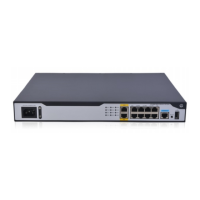26
Condition: This symptom might occur if the old pre-shared key is not deleted when the new key
is set.
201602170270
Symptom: On a CDMA-1xRTT/CDMA-EVDO network, 3G VPDN access fails if the mode of the
SIC-4G-LTE module is switched to 3G.
Condition: This symptom might occur if the mode of the SIC-4G-LTE module is switched to 3G.
201601260255
Symptom: After the router reboots, BFD sessions cannot be set up on subinterfaces that are in
an aggregation group.
Condition: This symptom might occur if the router reboots.
201603150157
Symptom: IMC obtains incorrect packet statistics for Layer 2 interfaces on an MSR2004-24
router.
Condition: This symptom might occur if IMC reads the packet statistics on Layer 2 interfaces of
an MSR2004-24 router.
201602260225
Symptom: An interface on an SIC-4/9FSW module cannot send broadcast traffic in its VLAN
after certain operations are performed.
Condition: This symptom might occur if the following operations are performed:
a. Enable STP globally, and form a loop on an interface of an SIC-4/9FSW module.
b. Remove the blocked interface from its VLAN.
c. Disable STP globally, and assign the interface to its original VLAN.
201602260270
Symptom: The router does not display the command execution result after AT commands are
manually executed.
Condition: None.
201603110385
Symptom: The router does not send a trap message after a warm or cold reboot.
Condition: This symptom might occur if a warm or cold reboot is performed.
201603240091
Symptom: Dialup fails if a 4G module is operating in 3G mode.
Condition: This symptom might occur if the following operations are performed:
a. Install a 4G SIM card in a 4G module.
b. Set the mode of the 4G module to 3G, and reboot the module.
201603100323
Symptom: When a portal preauthentication domain and MAC-based quick portal authentication
are used together, authorization attributes in the preauthentication domain do not take effect on
preauthentication users.
Condition: This symptom might occur if a portal preauthentication domain and MAC-based
quick portal authentication are used together, and MAC-based quick portal authentication is
triggered when preauthentication users access the network.

